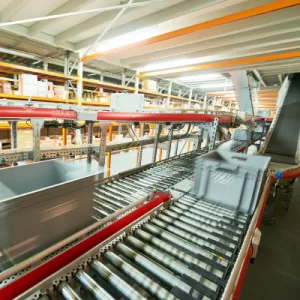 The warehousing landscape is undergoing an enormous and productive shift driven by a relentless wave of technological advancements.
The warehousing landscape is undergoing an enormous and productive shift driven by a relentless wave of technological advancements.
As businesses strive for enhanced efficiency, accuracy, and adaptability, warehouse management systems are emerging as a long-term solution.
Understand the importance of current warehouse automation trends and learn how specific systems are at the forefront of the warehouse automation revolution, redefining how goods are stored, retrieved, and managed.
Vertical Lift Modules
Vertical Lift Modules (VLMs) are becoming very prominent in modern warehousing. These automated systems feature a tall structure with an elevator to automatically deliver trays or shelves.
VLMs bring items to the operator, eliminating manual searching and walking, using a goods-to-person approach.
The result? A dramatic increase in picking speed, reduction in errors, and optimal space utilization.
VLMs are most productive when handling small parts and items that require high precision and quick retrieval.
Horizontal Carousels
Horizontal carousels take the goods-to-person concept a step further. These systems consist of a series of horizontally rotating bins or shelves. Items are placed on the shelves, and with a simple command, the carousel rotates to bring the required item to the operator.
This setup is ideal for high-speed picking scenarios and is particularly effective for businesses dealing with a high volume of orders containing multiple small items.
Vertical Carousels
In a vertical carousel, a series of shelves rotate vertically, allowing for efficient use of both floor space and ceiling height. Items are brought to the operator at an ergonomic height, reducing the risk of strain and improving picking accuracy.
Vertical carousels are versatile, making them suitable for various industries, including:
- Aerospace
- E-commerce
- Healthcare
- Manufacturing
- Retail
Robotics and Automation Integration
Automation in warehousing extends beyond just storage.
The integration of robotics introduces a new standard where machines and human workers collaborate seamlessly to achieve unparalleled levels of productivity and accuracy. Robotics have transcended their initial roles as mechanical assistants and evolved into intelligent, adaptable entities capable of performing an array of tasks previously thought to be exclusively human.
Tasks such as picking, packing, and transportation, which were once labor-intensive and time-consuming, are now being revolutionized by the presence of robots.
These robots are equipped with advanced sensors, cameras, and gripping mechanisms that enable them to navigate complex warehouse environments, identify items, and handle them with precision.
This technology not only expedites the fulfillment process but also minimizes errors, leading to higher customer satisfaction.
One of the most remarkable aspects of these robotic systems is their ability to work in harmony with human employees. Rather than replacing human workers, these robots complement their skills and capacities.
This collaborative approach optimizes the strengths of both parties: humans provide critical decision-making abilities, problem-solving skills, and contextual understanding, while robots contribute to speed, consistency, and accuracy.
Machine Learning for Demand Forecasting
Machine learning algorithms are ushering in a new era of precision and efficiency in warehouse management, particularly when it comes to inventory control and demand forecasting.
By harnessing the power of data, these algorithms are revolutionizing the way warehouses operate, optimizing their processes and enhancing their ability to meet customer demands effectively.
At the heart of this transformation is the ability of machine learning algorithms to analyze vast amounts of historical data, including past sales, order patterns, and inventory movement. By studying this data, these algorithms can identify subtle patterns and trends that human analysts might overlook. This historical analysis forms the foundation for generating accurate demand forecasts.
However, machine learning algorithms don’t stop at historical data; they also consider a myriad of external factors and market trends that can impact demand. These factors may range from seasonal changes, economic conditions, promotional events, and even global events that can cause fluctuations in customer demand. By incorporating these dynamic variables, machine learning algorithms create more comprehensive and realistic demand forecasts.
Why is it Important to Focus on Current Warehouse Automation Trends?
Focusing on current warehouse automation trends is important for several reasons that have a direct impact on a business’s success and competitiveness in today’s dynamic marketplace, including:
- Enhanced efficiency and productivity
- Workplace optimization
- Accuracy and quality
Achieving business success requires adaptability to ever-changing market dynamics to ensure high customer satisfaction. Establishing scalability and flexibility to accommodate growth and demand fluctuations and implementing strategies for cost savings while maintaining quality standards. These factors contribute to a well-rounded business model, positioning the organization for sustainable growth and enduring success.
Ultimately, the evolution of warehouse automation is reshaping how businesses manage their supply chains, reduce costs, and enhance customer satisfaction.
As technology continues to advance, the future promises even more groundbreaking solutions that will push the boundaries of efficiency and flexibility in the warehouse environment.
Focusing on current warehouse automation trends is not just about embracing technology; it’s about optimizing operations, improving customer experiences, and staying competitive in an ever-changing business environment.
By embracing these trends, companies can position themselves at the forefront of the warehouse automation revolution, prepared to meet the challenges and opportunities of a rapidly changing world.
